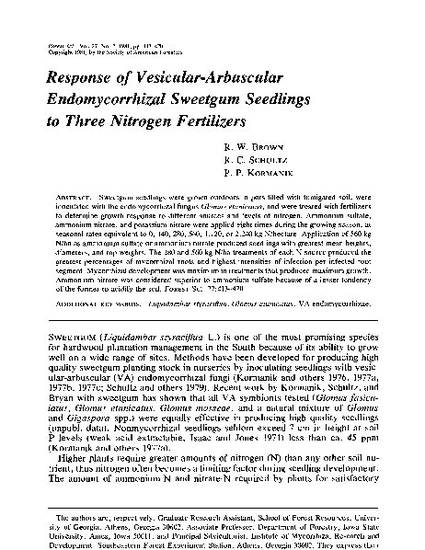
Article
Response of Vesicular-Arbuscular Endomycorrhizal Sweetgum Seedlings to Three Nitrogen Fertilizers
Forest Science
Document Type
Article
Disciplines
Publication Version
Published Version
Publication Date
6-1-1981
Abstract
Sweetgum seedlings were grown outdoors in pots filled with fumigated soil, were inoculated with the endomycorrhizal fungus Glomus etunicatus, and were treated with fertilizers to determine growth response to different sources and levels of nitrogen. Ammonium sulfate, ammonium nitrate, and potassium nitrate were applied eight times during the growing season, at seasonal rates equivalent to 0, 140, 280, 560, 1,120, or 2,240 kg N/hectare. Application of 560 kg N/ha as ammonium sulfate or ammonium nitrate produced seedlings with greatest mean heights, diameters, and top weights. The 280 and 560 kg N/ha treatments of each N source produced the greatest percentages of mycorrhizal roots and highest intensities of infection per infected root segment. Mycorrhizal development was maximum in treatments that produced maximum growth. Ammonium nitrate was considered superior to ammonium sulfate because of a lesser tendency of the former to acidify the soil.
Language
en
File Format
application/pdf
Citation Information
R. W. Brown, Richard C. Schultz and Paul P. Kormanik. "Response of Vesicular-Arbuscular Endomycorrhizal Sweetgum Seedlings to Three Nitrogen Fertilizers" Forest Science Vol. 27 Iss. 2 (1981) p. 413 - 420 Available at: http://works.bepress.com/richard_schultz/37/

Works produced by employees of the U.S. Government as part of their official duties are not copyrighted within the U.S. The content of this document is not copyrighted.